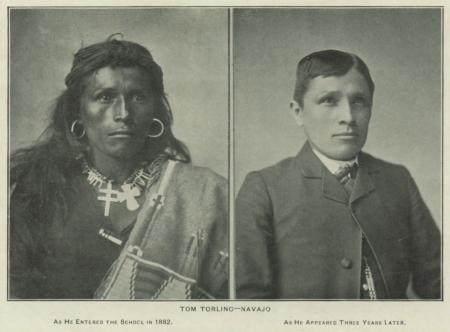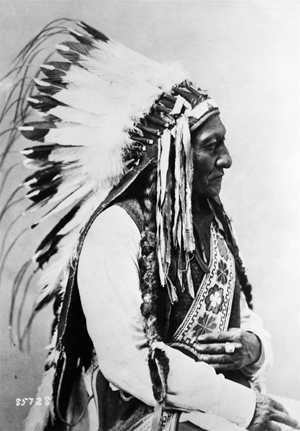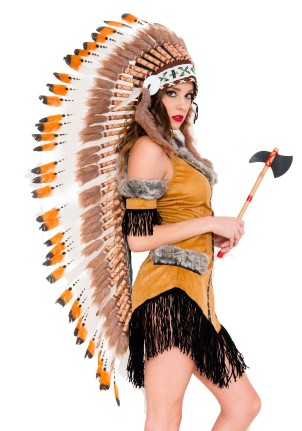As Halloween approaches, some of us aren’t thinking of corn mazes and candy. We’re preparing for the day we must defend our cultures from being fetishized and mocked. We have seen it all, from the “sexy Indian” to the downright racist #NoDAPL costumes where non-native women dressed up as “dumb, jobless Indians.” (Google it if you don’t believe me.)

This is especially hurtful to me—someone who feels the effects of colonization and assimilation deeply. Someone who is actively relearning traditions, language and ceremony because of institutional practices that were in place to eradicate these ways.
Since many Americans were not taught about our true history in school, I compiled a list of ways that our cultures were forbidden, and how they were forcibly stolen from us. The intent of this isn’t to dig up old trauma, but to explain the ways in which these practices are directly related to why it is so important for us to continue to protect our cultures from dishonor and exploitation.
Boarding Schools: Starting in the 1800s, Native children were sent to Christian boarding schools, sometimes thousands of miles away from home. This is true for many indigenous families, including my own, from my great-great Lala (grandfather) to my até (father). The founder of this system, Captain Richard Pratt, said, “All the Indian there is in the race should be dead. Kill the Indian in him, and save the man.” This meant rid him of his “savage” ways and turn him into a “civilized American”. Children were taken from their homes and sent to these schools where they would stay for years at a time. Many children became sick from being indoors and away from family, and many children died. These children suffered physical, emotional and sexual abuse at the hands of these non-native authority figures. They were forced to take Christian names. They were forced to cut their long, sacred hair. They were abused for speaking their native tongue. This was cultural cleansing, a form of genocide.

Forced adoption: Until 1976, Native children were forcibly removed from their homes and placed in white families as an attempt to assimilate. You can read my cousin’s story here. This has caused life long trauma for these displaced Natives. This prompted the creation of the Indian Child Welfare Act, which aims to keep Native children in Native families. You may have heard about this recently, as Texas has overturned it claiming it is “discriminatory towards non-natives”.
Relocation Program of 1956: A program designed to provide education and employment for Natives by relocating from reservations to distant urban cities. My até (father) relocated from Rosebud Reservation to Chicago, IL at the age of 18. He relocated for a radiology program. Many Native students in his program ended up leaving —too drastic of a change from home to a large city. It wasn’t easy. And location plays a significant part in how one can become displaced from community and ceremony.
American Indian Religious Freedom Act of 1978: Prior to 1978, it was flat out illegal for us to participate in our traditional ceremonies and ways of life. That was only 40 years ago. To any religious folk, imagine if you were forbidden from going to church or praying. That’s how it was for us.
Okay, but why does it matter if I wear a headdress?

The most commonly appropriated Headdress belongs to the Plains tribes, including my Lakota community. These headdresses are known for their cascading Eagle Feathers, each of which were rightfully earned for honorable deeds within the community. An Eagle Feather is similar to a war medal. Can you imagine if people wore imitation Army uniforms with fake war medals? Eagle Feathers were also earned for other honorable deeds. I received my first Eagle Feather upon graduating from high school. It is in a handmade frame that my até (father) made me. It is one of the most important and sacred items I own.
But what’s so bad about the “sexy Indian?”
Now onto the “sexy Indian” costume. This sexualization of Native women is dangerous because our women already face the highest rates of rape and sexual assault out of any other group.  Not only does this violence exist, but it goes on without consequence, even when these women report it. The last statistic seen for the number of Missing and Murdered Indigenous Women (MMIW) was 5,713. The United States does not have a database for the number of these women who are missing and murdered, so we do not have an accurate number. The recent reauthorization of VAWA (Violence Against Women Act) was the first step towards tribal governments ability to prosecute non-native offenders. Prior to this, non-native offenders would walk free if these crimes were committed on sovereign tribal nations. Dressing as a “sexy Indian” is further advancing the sexualized ideology of Native women and dehumanizes us. Women, we can do better!
Not only does this violence exist, but it goes on without consequence, even when these women report it. The last statistic seen for the number of Missing and Murdered Indigenous Women (MMIW) was 5,713. The United States does not have a database for the number of these women who are missing and murdered, so we do not have an accurate number. The recent reauthorization of VAWA (Violence Against Women Act) was the first step towards tribal governments ability to prosecute non-native offenders. Prior to this, non-native offenders would walk free if these crimes were committed on sovereign tribal nations. Dressing as a “sexy Indian” is further advancing the sexualized ideology of Native women and dehumanizes us. Women, we can do better!
One step towards doing better is demanding change. Yandy, an online retailer focusing on Halloween costumes, recently pulled their “Handmaid’s tale” costumes and issued an apology after public backlash. But when confronted about their $150,000 of sales from Native American costumes, the CEO said the costumes will remain until, “it gets to the point where there is, I guess, significant demonstrations or it gets to a point of contentiousness that maybe is along the lines of the Black Lives Matter movement.” This is another example of how our concerns go unheard, but the concerns of the dominating racial majority are listened to immediately. SIGN THIS PETITION to show Yandy that our culture is not a costume.
Is there an appropriate, respectful way to dress like a Native American for Halloween?
I would first examine the intent behind the desire to dress Native. Is it a fascination or idolization? If so, there are other respectful ways you can learn about the culture or contribute to our communities (see attached document). By dressing “Native”, you are perpetuating a pan-Indianism stereotype. If it’s a child who wants to dress like a “Native”, you have a great opportunity to teach them about our collective histories instead. Here is a link to several children books that can help you accomplish that.

So in summary, it’s not that I want to control what you wear or what you do, it’s that I am fiercely defending something of ours that is continually under attack. Our traditions, ceremonies and regalia are sacred and significant to us. Reducing us to mascots and meaningless costumes has detrimental effects. We know that it has a direct impact on the mental health of native youth.
If you find yourself upset after reading this article, I challenge you to sit with those emotions and figure out what is causing you to feel that way. If you feel I am impinging on your freedom to dress how you want, then hey you are actually pretty close to getting it! Remember, it costs nothing to respect people. I’m actually saving you $20 by asking you to not buy that imitation headdress.
As always, these thoughts are my own—a reconnecting Lakhota winyan. These thoughts do not reflect the entire indigenous community.

You did a FANTASTIC job! This article is not only needed in todays world due to appropriation, but will hopefully also educate those who have been stripped of their heritage (myself included among countless others). Thank you for using your emotional labor to educate. ❤
LikeLike
Thank you for reading and sharing my words, Faith!
LikeLike
I’m Aleut, and also one of those people who got adopted, as was my mother. My mother was born during the time when Native children were being forcibly removed. She died in 1986, so I never got to meet her. I’m grateful for all my adoptive family has done, and they’ve always encouraged my learning about my Native heritage, so I got very lucky in that way. But I still felt like part of me was “stolen” or “erased.” Only recently have I started reconnecting with my heritage, and life is making more sense. Thank you for this post, and for validating us. 💙
LikeLike
It sounds like we have similar paths, Renee ❤️ I’m glad you liked the article
LikeLike
❤️❤️❤️
LikeLike
❤️❤️
LikeLike
100% agree. I feel the same when it comes to people dressing up as “the day of the dead skull”. People always try to steal a culture that isn’t theirs, especially for profit. It’s disgusting and makes me uncomfortable & angry when non-Mexican people dress up as sugar skulls or (my favorite) in a sombrero and poncho.
LikeLike
I definitely relate to that uncomfortable feeling. ❤️
LikeLike
This is incredible Cali! Thank you for taking the time to educate everyone and pour your passion into making change. I love continually learning new things and being inspired to take action by your writing!
LikeLike
Thank you so much for taking the time to read and your enthusiasm to learn! I appreciate you!
LikeLike
Amazing write up! The lack of knowledge is what leads to poor choices. Stay proud of your heritage and keep educating people. Cultural diversity is what makes us unique.
LikeLike
I agree, Linda. If we could educate and raise awareness, there would be less ignorance and less hurtful, poor choices. Thank you for reading and taking the time to leave a comment!
LikeLike
Hello Cali_Wolf! Maybe I shouldn’t reply, since Iam a Swedish white man/ boy!?
Anyway, your article is a spot on view of the situation in your country or the world around it!
We can only believe & hope all these problems will be fewer or disapear completely (naive thought/wish?), how ever, YOUR thoughts, information & protests will & are an inspiration to others – no matter of gender, colour or history! Keep it up! 👍 #💪💓
LikeLike
I welcome comments from everyone! Thank you for your comment, I really appreciate it!
LikeLike
Magnificent article. These principles/awareness should be extended to the same treatment of Pacific Islanders…to the racist and sexist “hula girl” imagery that pervades toys ( Mattel and Disney are a big offenders), greeting card and party shop merchandise…the fake lei, coconut bras, white-skinned pin-up decorations, dashboard nodder dolls and all the rest of it. “Tiki bar” culture is essentially a white rip-off and trivialization of Kanaka Maoli and other Oceania nations…,₩and its practitioners will defend their silly imagery with the same anger and possessiveness as defenders of noxious and defamatory sports mascots. Thank you for your excellent article. (I am a woman of totally European ancestry, always grateful to listen to the voices of the First Peoples, deeply sorry about the horrendous injustices that continue to this day….trying to ever reeducate my brain and not be a part of the problem.)
LikeLiked by 1 person
Thank you for reading, and for your comment! Glad you enjoyed the article. And yes it applies to so many others as well!
LikeLike